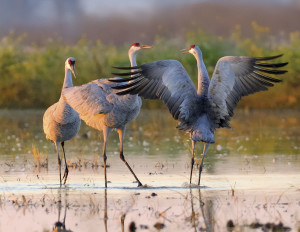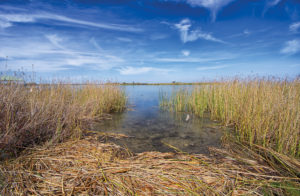Avian migration exhibits a planetary ebb and flow like that of an ocean tide—a pull across the latitudes exerted on whole populations of birds. Throngs of shorebirds and waterbirds come surging into our region from the Arctic north every autumn—they ride the frozen edge of winter south to California’s Central Valley.
Arriving on this seasonal swell of birds is the magnificent, normally cold-loving tundra swan. Large and vigorous, the adult tundra swan has pure white plumage, a jet-black bill and feet, a long neck, and powerful wings. Highly gregarious, these swans migrate and overwinter in flocks. When occasional wanderers show up in San Francisco Bay or along the coast, they are few in number.
Within the flock, whether in the air or on the ground, tundra swans maintain tight family bonds. Not only do mated adults stay loyal for life; they teach and protect their offspring through the young swans’ first migration and winter. Juvenile tundra swans have variably gray heads and upper necks.
Swans in North America
• The tundra swan has two subspecies, formerly recognized as separate species. The one native to North America (Cygnus columbianus columbianus) is also known as whistling swan (for the sound of its wings in flight). The Old World subspecies (found rarely here), known as the Bewick’s swan (C. columbianus bewickii), has variable, bright yellow patterning around the base of its bill.
• The trumpeter swan (Cygnus buccinator), also native to North America, is slightly larger than the tundra swan. Its population is small, and the species’ appearance is unusual in California in winter.
• The mute swan (Cygnus olor) was introduced here from Britain and Europe as early as the 1850s and today breeds in the wild, including in the Bay Area. It has a long slender neck, held in an S-curve, and a bright orange beak with a black knob at the base.
Voice is the matrix binding the swans together. They chatter among themselves while standing, while feeding, and even while roosting. When flying together—in strong V formations high overhead or in straight lines within a few hundred feet of the ground—tundra swans are often heard by humans before they are seen. Check for a shiver of bone-deep thrill if you experience this. The swan’s distinctive call—one to three flutey syllables, oo oh oo—pierces the winter air.
People seeking swan encounters near the Bay Area may head east to the Delta’s Staten Island or Cosumnes River Preserve. Farther north in the valley, birders visit the Sacramento National Wildlife Refuge complex or drive the small roads east of the Sutter Buttes. In either region, swans may comingle with sandhill cranes by the dozen or hundred, geese and ducks by the ten thousand.
The landscapes to inspect will be broad shallow ponds, wetlands, or harvested agricultural fields. Tundra swans are well equipped for aquatic feasting, using the headstand known as dabbling. They upend their jet-black feet in order to snorkle deep, probing with intention for roots and tubers and seeds. They also thrive by grazing in harvested farmlands: the swans (along with cranes and geese, perhaps) will walk about prodding the soggy stubble where seeds remain—especially corn, grown for silage to feed cattle.
Tundra swans are restless birds—perpetually ready to lift a thousand strong into the air and go someplace else. A human watcher, coming upon a winter field full of the birds, may do well to pause without disturbing them; a safely parked car serves well as a blind. Wait, and watch. First, a collective twitch may run through the flock, and voices rise. Then a few thousand feet take quick running steps and a cloud of large white birds, fervently calling, lifts into the sky.
The tundra swan seems to represent the cold north, even in California. It arrives in large numbers after the first autumn frost and departs before the winter’s last freeze. To see and hear a skein of tundra swans flying hard and strong is to feel the hemispheric tide of migratory birds.





